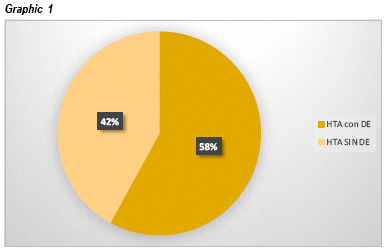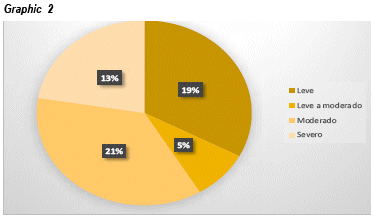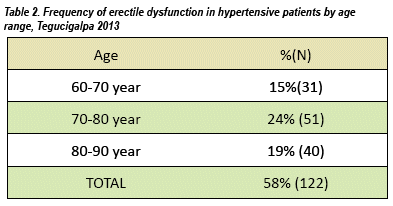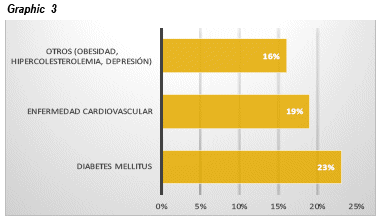Services on Demand
Journal
Article
Indicators
-
 Cited by SciELO
Cited by SciELO -
 Access statistics
Access statistics
Related links
-
 Similars in
SciELO
Similars in
SciELO
Share
Revista Científica Ciencia Médica
Print version ISSN 2077-3323
Rev Cient Cienc Méd vol.21 no.1 Cochabamba 2018
Original article
ERECTILE DYSFUNCTION IN MALE GERIATRIC POPULATION WITH ARTERIAL HYPERTENSION IN TEGUCIGALPA HONDURAS
María José Folgar Contreras1, Milagromaria Ramos Rodriguez2, Keily Sarahi Pastrana Gonzales3.
1,2,3Doctora en Medicina y Cirugía. Universidad Católica de Honduras.
Address: Colonia las Colinas, bloque RR, 4ta casa después del Liceo Franco Hondureño, Tegucigalpa, Honduras.
Correspondence to: María José Folgar Contreras folgarmj@gmail.com Cell phone: +504 98865105
Received for publication: May, 20 2017
Accepted for publication: July, 14 2018
Cite as: Rev Cient Cienc Med 2018;21(1):60-67
ABSTRACT
Introduction: Erectile Dysfunction is currently recognized as a multifactorial disease in which psychological, neurological, endocrine, vascular, traumatic, life-style, environmental and iatrogenic causes coexist. Although it is a benign disease, it affects both physical and psychosocial health, resulting in the affectation of the quality of life of those who suffer it. Objective: To determine the prevalence of erectile dysfunction in hypertensive male patients attending the outpatient clinic of the “Centro de Atención Integral del Adulto Mayor”. Methodology: A cross-sectional descriptive study was carried out, taking a sample of 210 individuals from a universe of 465, obtaining data from the application of two surveys to male and hypertensive patients in the months of October and November of the year 2013. Surveys Included general questions and the International Erectile Function Index (IIEF-5). Results: The sample showed that the prevalence of erectile dysfunction in hypertensive male patients attending the outpatient clinic of the Centro de Atención Integral del Adulto Mayor was 58%. Conclusions: In our male and hypertensive geriatric population attending the outpatient clinic of the Centro de Atencion Integral del Adulto Mayor, there is a high prevalence of erectile dysfunction, presenting more frequently in a range of advanced age due to concomitant diseases.
Keywords: Erectile dysfunction, Hypertension, Elderly.
INTRODUCTION
Erectile dysfunction is defined as the consistent (durable, stable) inability to achieve or maintain a penile erection sufficient to allow a satisfactory sexual relationship1. Although it is considered a benign disease, it has a high impact on the quality of life of the person who suffers it. As well as that of his partner, since it affects the individual from the physical to the emotional2.
In the year of 1573 Varilo explained the erection as a result of a venous restriction mechanism3. However, it was from the concepts by Freud that it was considered of a psychological origin1. Currently, there are three basic mechanisms known that can cause erectile dysfunction: inability to initiate an erection (psychogenic, endocrine or neurogenic cause), insufficient filling (arteriogenic) and the inability to store a sufficient volume of blood in the lacunar network (dysfunction veno-occlusive)4.
Erectile dysfunction is recognized as a multifactorial disease in which psychic, neurogenic, endocrine causes coexist; concomitant diseases such as diabetes, vascular, traumatic; causes related to drugs, lifestyles and even iatrogenic causes have been described2. Erectile dysfunction and hypertension share the same risk factors (sedentary lifestyle, obesity, alcohol and smoking), which are in turn associated with endothelial dysfunction5.
A high prevalence has been found in patients with erectile dysfunction and arterial hypertension, which may be due to endothelial damage in the arterial wall of the corpora cavernosa, and due to the effect that certain antihypertensive drugs produce in the erection6. Since arterial hypertension is a very frequent, poorly controlled chronic endothelial disease that coexists with erectile dysfunction, it is very useful to know the frequency of the relationship between arterial hypertension and erectile dysfunction in the geriatric population.
In this study, the prevalence of erectile dysfunction in its different degrees was determined in hypertensive male patients who attended the outpatient clinic of the Integral Care Center for the Elderly, evidencing other diseases that coexist with erectile dysfunction; which has traditionally been classified as a phenomenon resulting from age. Although it is true, it is concomitant of some physiological and psychic changes of old age. Today it is considered a disease. For this reason it is intended through this, to demonstrate the need to handle the disease comprehensively and considering the increase in the cases of it, suggest creating preventive measures.
MATERIALS AND METHODS
A cross-sectional descriptive study was conducted, taking a sample of 210 men from a population of 465 male and hypertensive patients who attended the Center for Integral Care of the Elderly (CAIAM) in Tegucigalpa, Honduras, in the months of October and November 2013 the inclusion criteria were male patients diagnosed with hypertension and treated at the Integral Care Center for the Elderly (CAIAM), aged between 60 and 90 years; and signed informed consent. Men without arterial hypertension were excluded. The data was obtained through the application of two instruments; after having obtained the signed informed consent of each patient. The first was a survey with data of a general nature and the second the international index of erectile dysfunction (IIEF-5) that considers patients based on a score of 22-25 without erectile dysfunction; 17-21 with mild grade, 12-16 with mild to moderate grade, 8-11 with moderate grade, and 5-7 with severe grade. For the data analysis, these were introduced and stored in the Epi-info statistical program version 3.01. With them, tables and graphs were made in Microsoft Excel for Mac 2011, version 14.1.0. The sample size was calculated based on a confidence level of 95% and a margin of error of 5%.
RESULTS
Two surveys were applied to a sample of 210 hypertensive men, all of whom were adequately filled. Of these 210 respondents, 58% (122) resulted with some degree of erectile dysfunction (See graph 1).The score obtained in the IIEF-5 questionnaire helped to obtain the severity of the erectile dysfunction (See table 1); It was found that, of the 122 men with erectile dysfunction, the majority had erectile dysfunction in a moderate degree 21% (44), followed by erectile dysfunction in a slight degree 19% (40), 13% (27) severe degree and 5% (11) moderate to severe degree (see graph 2). It was shown that, in the 122 men with erectile dysfunction, the risk of erectile dysfunction was higher after 70 years 43% (91) (See table 2). Within this population of respondents, more men aged 70 to 80 years were studied 45% (94).
In the 122 hypertensive patients studied who presented erectile dysfunction, other concomitant diseases were found. The most prevalent diseases were diabetes mellitus in 23% (48) and cardiovascular disease 19% (40); however, 16% (34) presented other diseases apart from hypertension, among which are hypercholesterolemia, obesity, depression (see graph 3).
DISCUSSION
The prevalence of erectile dysfunction varies between countries, regions and cities, is between 10 and 52% in men between 40 and 70 years, with an incidence in Western countries of 25-30 new cases per 1 000 inhabitants per year8. In our study conducted at the CAIAM in 2013, we established the prevalence of erectile dysfunction in the hypertensive patient, obtaining comparable results with national and international statistics.
A study of 100 patients with an average age of 60 years in a third level hospital in Colombia, revealed a prevalence of erectile dysfunction of 66%, mostly mild. Relating its causes, when performing the statistical analysis, it was found that hypertension was the only cause that showed statistical significance, suggesting that it is six times more likely to be found in patients with erectile dysfunction9. In Honduras, a study was conducted on 371 individuals in the city of Siguatepeque, finding that the frequency of erectile dysfunction was 58% (214), the degree of dysfunction found was: Mild 114 (53%), mild to moderate 57 (27%), moderate 18 (8%), and severe 25 (12%)2; this study conducted in a city 120 kilometers north of Tegucigalpa, had an identical result to that found in the CAIAM; evidencing that in the central zone of Honduras the frequency of erectile dysfunction in hypertensive men is high. The data on the frequency of erectile dysfunction in hypertensive patients are increasing in parallel with hypertension as seen in data provided by the WHO, which shows that the number of people affected increased from 600 million in 1980 to 1000 million in 2008, a figure that to date is on the rise10.
Similarly, in another study where the sample was 100 patients in Colombia, 69% of men with erectile dysfunction were found11. A similar result was found in a study conducted in Mexico, where a sample of 479 diabetic patients was taken, finding 67% of them with erectile dysfunction12. This increase in cases in relation to this study in Tegucigalpa may be due to a higher prevalence of hypertension and diabetes in these countries in relation to Honduras13.
However, in a study conducted in Spain in which 2 453 patients were studied, it was found that 76% were hypertensive; and of these 40% were found with some degree of erectile dysfunction. Another study in this country with a sample of 512 hypertensive patients reported 46,5% of men with some degree of erectile dysfunction. We can observe fluctuation in the results of these studies with this one. Which is attributed to the fact that the difference in the population with erectile dysfunction varies according to the country15.
A finding of this study as well as in the other national and international studies, was that in male patients older than 70 years, there was a greater number of men with impaired erectile function. This suggests that the deterioration of the vascular endothelium increases along with the normal aging process7.
Regarding diabetes mellitus, the prevalence of erectile dysfunction is between 20 and 50%; if s appearance is usually 10 to 15 years earlier than in the general population7. Erectile dysfunction is a sign of vascular disease in subjects with diabetes mellitus type 214. In the same study conducted in Siguatepeque, Honduras, it was found that of the 58% of patients with erectile dysfunction, 31% were hypertensive with 20% of diabetics2. In the CAIAM, of 58% of hypertensive patients with erectile dysfunction, 23% also presented diabetes mellitus, evidencing similar percentages among patients from both cities in the same country. In contrast to the aforementioned study in Mexico in which 67% of erectile dysfunction frequency was observed in diabetic patients and 72% of hypertension association with diabetes mellitus12. This tells us that diabetes mellitus also represents a high risk factor for erectile dysfunction7.
The prevalence found in the CAIAM was similar to the observed in other studies with higher, lower and equal scale. Checking that erectile dysfunction is a worldwide problem of high prevalence, which is increasing. In our hypertensive geriatric population attending the outpatient clinic of the Integral Care Center for the Elderly, this high prevalence is confirmed in elderly men, vulnerable to suffer from cardiovascular diseases that lead to the appearance of erectile dysfunction. This conjecture should be confirmed with more in-depth studies on the relationship of cardiovascular diseases with erectile dysfunction in Honduras.
ACKNOWLEDGEMENTS
We thank Dr. Ángel Pineda, for facilitating the application of instruments in the Integral Attention Center for the Elderly (CAIAM) of the city of Tegucigalpa.
REFERENCES
1. Romero C. Disfunción eréctil y enfermedad cardiovascular. Revista. Uruguay. Cardiología 2008; 23(1): 65- 70.
2. E. Wespes, E. Amar, I. Eardley, F. Giuliano, D. Hatzichristou, K. Hatzimouratidis, F. Montorsi, Y. Vardi DISFUNCIÓN SEXUAL MASCULINA: Disfunción eréctil y eyaculación precoz (Actualización del texto: Marzo de 2009) European Association of Urology 2010.
3. Roger S. Culley C. Goldstein I. Wyllie M. ERECTILE DYSFUNCTION: A CLINICAL GUIDE. Segunda Edición, USA, Informa HealthCare, New York 2009. P. 3.
4. Fauci A. Kasper D. Longo D. Loscalzo J. Jameson J. Hauser S. Braunwald E., Harrison Principios de Medicina Interna. Tomo 1. 17 edición McGraw-Hill interamericana, 2009. Pag.296-300
5. Odriozola A., Quintanilla M., Arias Pereira J., Tamayo A., Gonzales G., Disfunción Eréctil De Origen Vascular, Hospital de Galdako-Usansolo. Vizcaya, España, Arch Esp. Urol. Vol 63 No.8 Oct 2010.
6. Rodriguez A., Roldan C., Marcos M., Rios R., Sarek I., Lopezo J.Factores Influyentes en la aparición de Disfunción Eréctil. JONNPR. 2016;1(3):107-114.
7. Zavala G., Núñez R., Portillo E., Reyes A., Bourdeth A., Sergio D. DISFUNCIÓN ERÉCTIL EN POBLACIÓN MASCULINA MAYOR DE 35 AÑOS EN LA CIUDAD DE SIGUATEPEQUE (Erectile dysfunction in men above 35 in Siguatepeque, Honduras) Rev. Fac. Ciencias Médicas Enero-junio 2011 Vol 8(1) P.9-20
8. Castro R., Hernández P., Casilda R., García J., et al EPIDEMIOLOGÍA DE LA DISFUNCIÓN ERÉCTIL. FACTORES DE RIESGO, Unidad de Andrología Medicina Sexual y Reproductiva. Unidad Clínica de Urología. Hospital Regional Universitario Reina Sofía. Córdoba. España. Arch. Esp. Urol. 2010; 63 (8): 637-639.
9. Robayo A., Garcia P., Herneng A., Carbonell G., Prevalencia de Disfunción Eréctil y factores asociados en un hospital de tercer nivel, Universidad del Valle, Colombia; Urol. Colom. Vol XVIII, No.1:pp 39-46 , 2009.
10. OMS, Información general sobre hipertensión en el mundo, Ginebra, Suiza 2013, http://apps.who.int/iris/bitstream/10665/87679/1/WHO_DCO_WHD_2013.2_spa.pdf
11. Díaz C., Arias C., Barrios J., Ballestas C., Prevalencia de disfunción eréctil en pacientes hipertensos del Hospital Universitario del Caribe, Sociedad Colombiana de Urología Mayo 2013 Volumen 22 (1), P. 41-46.
12. Fong E., JaramilloA., Prevalencia de disfunción eréctil en pacientes diabéticos, México, Med Int., 2007, Vol.23 (6) P. 477-80.
13. OPS, fundación hondureña de diabetes, secretaria de salud. Iniciativa Centroamericana de diabetes (CAMDI). Encuesta de diabetes, hipertensión y factores de riesgo de enfermedades crónicas. Tegucigalpa, Honduras 2009.
14. Juanatey J., Ezquerra E., Barbera R., Salvador M., et al. .Disfuncion Eréctil Como Marcador De Vasculopatía En La Diabetes Mellitus En España, Elsevier Med Clin (Barc). 2009; 132(8):291–297.
15. Cuéllar de León A., Campos González J., Muntó F., Martínez A., Gosalbes Soler V., Prosper Sierra M., Silvestre Quilez S., Valero García P., HIPERTENSIÓN ARTERIAL Y DISFUNCIÓN ERÉCTIL Revista de Urología de la SVMFYC España 2011.
1. Romero C. Disfunción eréctil y enfermedad cardiovascular. Revista. Uruguay. Cardiología 2008; 23(1): 65- 70. [ Links ]
2. E. Wespes, E. Amar, I. Eardley, F. Giuliano, D. Hatzichristou, K. Hatzimouratidis, F. Montorsi, Y. Vardi DISFUNCIÓN SEXUAL MASCULINA: Disfunción eréctil y eyaculación precoz (Actualización del texto: Marzo de 2009) European Association of Urology 2010.
3. Roger S. Culley C. Goldstein I. Wyllie M. ERECTILE DYSFUNCTION: A CLINICAL GUIDE. Segunda Edición, USA, Informa HealthCare, New York 2009. P. 3.
4. Fauci A. Kasper D. Longo D. Loscalzo J. Jameson J. Hauser S. Braunwald E., Harrison Principios de Medicina Interna. Tomo 1. 17 edición McGraw-Hill interamericana, 2009. Pag.296-300
5. Odriozola A., Quintanilla M., Arias Pereira J., Tamayo A., Gonzales G., Disfunción Eréctil De Origen Vascular, Hospital de Galdako-Usansolo. Vizcaya, España, Arch Esp. Urol. Vol 63 No.8 Oct 2010.
6. Rodriguez A., Roldan C., Marcos M., Rios R., Sarek I., Lopezo J.Factores Influyentes en la aparición de Disfunción Eréctil. JONNPR. 2016;1(3):107-114. [ Links ]
7. Zavala G., Núñez R., Portillo E., Reyes A., Bourdeth A., Sergio D. DISFUNCIÓN ERÉCTIL EN POBLACIÓN MASCULINA MAYOR DE 35 AÑOS EN LA CIUDAD DE SIGUATEPEQUE (Erectile dysfunction in men above 35 in Siguatepeque, Honduras) Rev. Fac. Ciencias Médicas Enero-junio 2011 Vol 8(1) P.9-20
8. Castro R., Hernández P., Casilda R., García J., et al EPIDEMIOLOGÍA DE LA DISFUNCIÓN ERÉCTIL. FACTORES DE RIESGO, Unidad de Andrología Medicina Sexual y Reproductiva. Unidad Clínica de Urología. Hospital Regional Universitario Reina Sofía. Córdoba. España. Arch. Esp. Urol. 2010; 63 (8): 637-639.
9. Robayo A., Garcia P., Herneng A., Carbonell G., Prevalencia de Disfunción Eréctil y factores asociados en un hospital de tercer nivel, Universidad del Valle, Colombia; Urol. Colom. Vol XVIII, No.1:pp 39-46 , 2009.
10. OMS, Información general sobre hipertensión en el mundo, Ginebra, Suiza 2013, http://apps.who.int/iris/bitstream/10665/87679/1/WHO_DCO_WHD_2013.2_spa.pdf [ Links ]
11. Díaz C., Arias C., Barrios J., Ballestas C., Prevalencia de disfunción eréctil en pacientes hipertensos del Hospital Universitario del Caribe, Sociedad Colombiana de Urología Mayo 2013 Volumen 22 (1), P. 41-46.
12. Fong E., JaramilloA., Prevalencia de disfunción eréctil en pacientes diabéticos, México, Med Int., 2007, Vol.23 (6) P. 477-80.
13. OPS, fundación hondureña de diabetes, secretaria de salud. Iniciativa Centroamericana de diabetes (CAMDI). Encuesta de diabetes, hipertensión y factores de riesgo de enfermedades crónicas. Tegucigalpa, Honduras 2009. [ Links ]
14. Juanatey J., Ezquerra E., Barbera R., Salvador M., et al. .Disfuncion Eréctil Como Marcador De Vasculopatía En La Diabetes Mellitus En España, Elsevier Med Clin (Barc). 2009; 132(8):291–297.
15. Cuéllar de León A., Campos González J., Muntó F., Martínez A., Gosalbes Soler V., Prosper Sierra M., Silvestre Quilez S., Valero García P., HIPERTENSIÓN ARTERIAL Y DISFUNCIÓN ERÉCTIL Revista de Urología de la SVMFYC España 2011. [ Links ]











 text in
text in 







